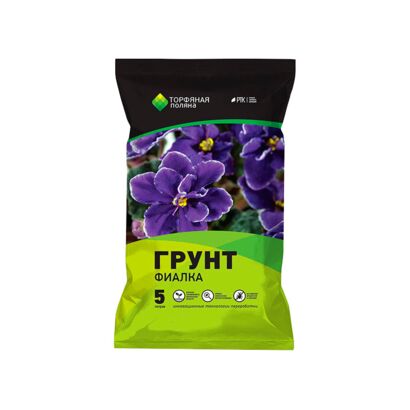soil for violets
View: nutritious peat soil
Purpose: cultivation of violets
Acidity: slightly acidic, pH 5.5
Moisture content by mass: ≤65%
Production: Russia
Volume: 5 l.
| Peat soils (series) | flower series |
The VASKhNiL nursery offers to buy nutrient soil for growing violets based on high-moor peat from environmentally friendly deposits in the Smolensk and Sverdlovsk regions.
Peat soil for violets
A peat-based ready-mix with a light texture and essential nutrients for all types of violets (saintpaulia, primrose).
Composition:
- Mixture of peat of varying degrees of decomposition.
- Limestone flour – acid neutralizer.
- Azophoska – complex nitrogen-phosphorus-potassium fertilizer.
Nutritional content:
(in plant-friendly form)
- Nitrogen (NH4 + N03) ≤110 mg/l
- Phosphorus (P2O5) ≤120 mg/l
- Potassium (K2O) ≤180 mg/l
Violet cultivation requirements
Violet – fussy flower. For its successful cultivation, it is necessary to choose the right pots, provide optimal humidity, good lighting, and protect the plant from drafts.
Suitable peat soil for violets:
- has a weak or neutral acidity - pH 5.5 to 6.5;
- has a loose texture;
- breathable well;
- absorbs excess moisture.
Application
Leaf propagation
Healthy stalk leaf at least 4 cm long is placed in water so that it gives roots. Then planted in a pot filled with peat soil. Lightly tamp and water.
Planting a leaf without roots
A layer of expanded clay or pebbles about 2 cm thick is placed on the bottom of the container with drainage holes, peat soil is applied on top. The sheet is placed in a container at an angle and sprinkled with a second portion of soil.
The pot is half lowered into the water. It is absorbed through the drainage holes at the bottom and saturates the soil with moisture. As soon as new leaves appear, the lower watering is replaced by spraying.
Transplanting violets
Drainage (expanded clay, pebbles) is laid out at the bottom of the pot. Peat soil is poured on top. The violet is placed in the middle of the container and filled with a second portion of the soil to the lower leaves. In order for the peat substrate to fill the voids, the pot is gently shaken. The top layer is lightly tamped and watered with water at room temperature.
